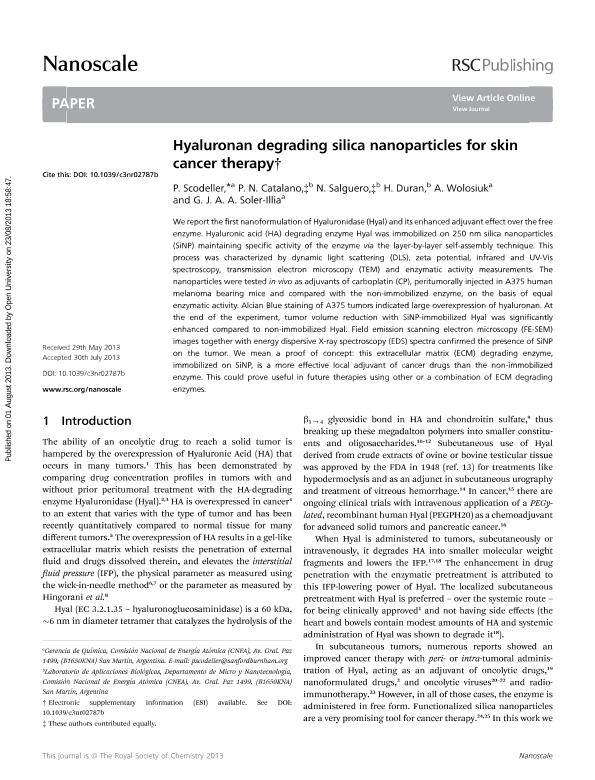Artículo
Hyaluronan degrading silica nanoparticles for skin cancer therapy
Scodeller, Pablo David ; Catalano, Paolo Nicolás
; Catalano, Paolo Nicolás ; Salguero, Noelia; Duran, Hebe Alicia
; Salguero, Noelia; Duran, Hebe Alicia ; Wolosiuk, Alejandro
; Wolosiuk, Alejandro ; Soler Illia, Galo Juan de Avila Arturo
; Soler Illia, Galo Juan de Avila Arturo
 ; Catalano, Paolo Nicolás
; Catalano, Paolo Nicolás ; Salguero, Noelia; Duran, Hebe Alicia
; Salguero, Noelia; Duran, Hebe Alicia ; Wolosiuk, Alejandro
; Wolosiuk, Alejandro ; Soler Illia, Galo Juan de Avila Arturo
; Soler Illia, Galo Juan de Avila Arturo
Fecha de publicación:
07/2013
Editorial:
Royal Society of Chemistry
Revista:
Nanoscale
ISSN:
2040-3364
Idioma:
Inglés
Tipo de recurso:
Artículo publicado
Clasificación temática:
Resumen
We report the first nanoformulation of Hyaluronidase (Hyal) and its enhanced adjuvant effect over the free enzyme. Hyaluronic acid (HA) degrading enzyme Hyal was immobilized on 250 nm silica nanoparticles (SiNP) maintaining specific activity of the enzyme via the layer-by-layer self-assembly technique. This process was characterized by dynamic light scattering (DLS), zeta potential, infrared and UV-Vis spectroscopy, transmission electron microscopy (TEM) and enzymatic activity measurements. The nanoparticles were tested in vivo as adjuvants of carboplatin (CP), peritumorally injected in A375 human melanoma bearing mice and compared with the non-immobilized enzyme, on the basis of equal enzymatic activity. Alcian Blue staining of A375 tumors indicated large overexpression of hyaluronan. At the end of the experiment, tumor volume reduction with SiNP-immobilized Hyal was significantly enhanced compared to non-immobilized Hyal. Field emission scanning electron microscopy (FE-SEM) images together with energy dispersive X-ray spectroscopy (EDS) spectra confirmed the presence of SiNP on the tumor. We mean a proof of concept: this extracellular matrix (ECM) degrading enzyme, immobilized on SiNP, is a more effective local adjuvant of cancer drugs than the non-immobilized enzyme. This could prove useful in future therapies using other or a combination of ECM degrading enzymes.
Archivos asociados
Licencia
Identificadores
Colecciones
Articulos(SEDE CENTRAL)
Articulos de SEDE CENTRAL
Articulos de SEDE CENTRAL
Citación
Scodeller, Pablo David; Catalano, Paolo Nicolás; Salguero, Noelia; Duran, Hebe Alicia; Wolosiuk, Alejandro; et al.; Hyaluronan degrading silica nanoparticles for skin cancer therapy; Royal Society of Chemistry; Nanoscale; 5; 20; 7-2013; 9690-9698
Compartir
Altmétricas



